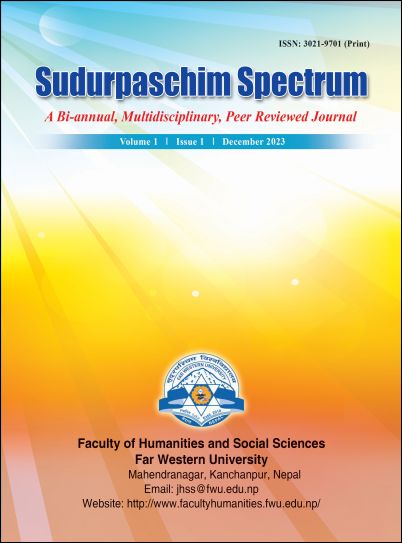Using Chemical Fertilizer to Major Cereal Crops in Baijnath Tole, Bhimdutta Municipality-19, Kanchanpur
DOI:
https://doi.org/10.3126/sudurpaschim.v1i1.63392Keywords:
Agriculture, crops, chemical fertilizer, production, wheat, paddyAbstract
The study, conducted in Baijnath tole, Bhimdatta municipality-19, Kanchanpur, Nepal, focuses on evaluating the impact of a chemical fertilizer pattern on major cereal crops, specifically paddy and wheat. Employing an empirical research with census survey method, the research investigates macronutrients, fertilizer sources, application rates, nutrient supply, and crop productivity. Data collected from 65 households using a semi structured questionnaire. By combining qualitative and quantitative data sources, it becomes evident that there has been a steady annual growth rate of around 12% in the utilization of chemical fertilizers for both paddy and wheat crops since the year 2075. This rise correlates with increased crop production, showing an average annual growth of 6% in paddy yields and a reversal of a 1% initial decrease in wheat, leading to a subsequent 4% annual increase over four years.
This research study contributes by providing insights into specific agronomic techniques connected to the use of chemical fertilizers on important grain crops in the area. If the research tackles unique difficulties or opportunities in the study area, it could provide useful information to local farmers and others. This could include soil types, climate conditions, and socioeconomic aspects. The study investigates the economic elements of chemical fertilizer use, taking into account issues such as input costs, farmer return on investment, and the overall economic impact on Nepalese agriculture. This study examines the impacts of chemical fertilizer use on soil health and the environment, taking into account factors such as soil fertility, nutrient runoff, and any environmental sustainability concerns. The study presents findings on how the use of chemical fertilizers affects the productivity of main cereal crops, as well as data on yield improvements, crop quality, and potential obstacles or constraints.
Downloads
Downloads
Published
How to Cite
Issue
Section
License
Copyright (c) 2023 The Author(s)

This work is licensed under a Creative Commons Attribution-NonCommercial 4.0 International License.
This license enables reusers to distribute, remix, adapt, and build upon the material in any medium or format for noncommercial purposes only, and only so long as attribution is given to the creator.




